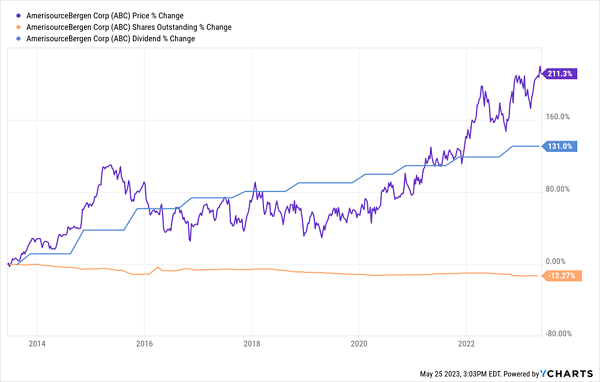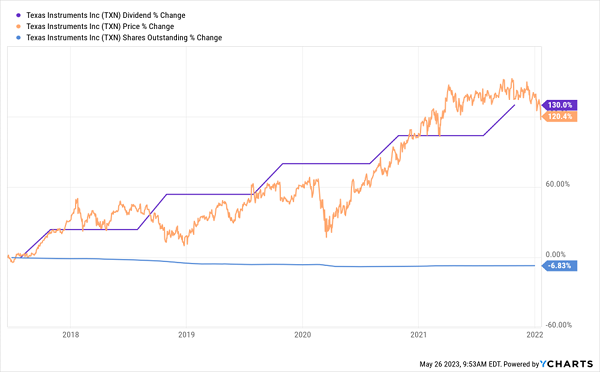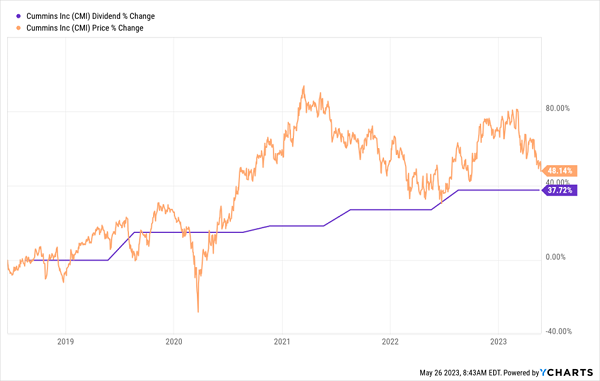There’s a $600-billion river of cash flowing straight out of Corporate America—and straight into some dividend investors’ pockets. Today we’re going to grab our share.
Companies don’t make much of the cash outlays we’re going to talk about. You might catch a line or two about them in an earnings release, but that’s it. That’s because they’re trying to stay below the radar of the Biden Administration, which is starting to tax these payouts, and has even threatened to quadruple the slice they’re taking now.
As for us, we’re not really focused on these cash payouts themselves (though we’ll happily take our share!). We’re keen on how they combine with our growing dividends to form a “Dividend-Buyback Feedback Loop” that can double, or more, the share prices on our favorite stocks.
A $600-Billion “Cash River” to Float Our Dividends
All right, I’ll come clean: these payouts aren’t really secret at all. I’m talking about share buybacks, $600 billion of which have been announced by Russell 3000 companies (or the 3,000 biggest US public companies) so far this year. That’s near a record, according to the folks at Birinyi Associates.
I didn’t use the word “buybacks” off the top because people’s eyes usually glaze over when I do. But we contrarian dividend investors know better than to ignore buybacks. Because when you find a company with a smartly run buyback plan and a growing dividend, you’re almost sure to find a growing share price, too.
It’s the most powerful investment strategy I know. Look at the chart below for drug distributor AmerisourceBergen (NYSE:ABC), which was a holding of my Hidden Yields dividend-growth advisory from June 2020 to December 2022, generating a 69% return in that time.
But go back a decade and you see something intriguing: as ABC’s dividend rose 131%, its share price trotted higher with it. But take a look at the orange line at the bottom—that’s the reduction in ABC’s share count due to buybacks:
ABC’s “Dividend-Buyback Feedback Loop” in Action

You can clearly see that as those buybacks accelerated, the share price was “juiced” higher than ABC’s payout growth. I’ve seen that again and again in dividend stocks. Like with former Hidden Yields holding Texas Instruments (NASDAQ:TXN), which we rode to a stout 148% return in just under five years:
TXN Knows How to Run a Dividend-Buyback Feedback Loop
Our “dividend-buyback feedback loop,” then, rolls like this:
- Management raises the dividend, driving up the current yield on the stock.
- Investors see that raise and bid the price up (and the yield back down). The excitement over the higher payout then fades.
- But then management sweetens the pot by repurchasing their own stock. The resulting extra demand boosts the share price further.
There’s more, too, because buybacks cut the number of shares on which the company has to pay dividends, boosting future per-share payouts!
That’s where then real action is—getting in on one of these feedback loops and hanging on as buybacks, dividends and share prices feed off each other over and over again.
The good news is there are plenty of companies doing this. Many are among those that have announced that $600 billion in buybacks I mentioned earlier.
Throw in another year of dividend growth (the latest estimate is for 5% payout increases this year across the S&P 500). You tilt the odds sharply in your favor, no matter what happens with the debt ceiling, the banking crisis, inflation or whatever other “wall of worry” the market is climbing on any given day.
But even so, I do have a caveat: we only want to target companies buying back shares the right way—that is, when the stock is cheap. Otherwise, they’re just burning cash.
With that in mind, let’s zero in on a stock with a management team of “buyback jedis” the likes of which I’ve rarely seen. This one is also a habitual dividend grower whose shares are cheap, making them attractive to management—and to us!
CMI’s Classic Dividend-Buyback Feedback Loop
Engine maker Cummins Inc. (NYSE:CMI) isn’t a stock most dividend investors think of often because its industry can be volatile, as truck demand swings with the economy.
But we should be keeping Cummins high on our list, for many reasons: for one, it “starts us off” with a 3% yield, much higher than the typical S&P 500 name. Thanks to that and its 38% dividend growth in the last five years, you’d already be yielding 4.6% today if you’d bought back then.
That payout growth, on its own, has pulled the share price higher.
The “Dividend” Part of CMI’s Feedback Loop Is in Play
The firm has been posting solid sales growth in the last five years and saw sales rise 8% in the first quarter, as truck demand jumped in North America and the Chinese construction market improved. Cummins also recently boosted its sales outlook for the year, to 15% to 20% growth over last year from 12% to 17%.
So it’s got plenty of growth to keep that dividend rising. Now let’s talk buybacks because there’s a pattern here that is, frankly, stunning:
Management’s Buyback Precision Is Unmatched
Above we’ve got a chart of CMI’s number of shares outstanding (orange line) laid over the P/E ratio (purple). As you can see, the orange line gets steeper (meaning CMI is buying back more shares) when the ratio falls and levels off when the P/E moves up.
That’s a clear sign of a management team that knows how to bargain-hunt its shares, and they’ve got another opportunity now, with CMI boasting a P/E of just 11.9. That’s what I call a “shoe size” P/E, and they’re not very common these days, even with the market still off its highs after last year’s dumpster fire.
Finally, Cummins’ strong balance sheet gives it a buffer in case of recession, with $2.4 billion of cash and long-term debt of $7.75 billion, for net debt of $5.3 billion.
That’s a small fraction of its market cap (or value as a public company) of $30 billion—and yet another reason why CMI—and its expertly run Dividend-Buyback Feedback Loop—is worth our attention now.
Disclosure: Brett Owens and Michael Foster are contrarian income investors who look for undervalued stocks/funds across the U.S. markets. Click here to learn how to profit from their strategies in the latest report, "7 Great Dividend Growth Stocks for a Secure Retirement."
